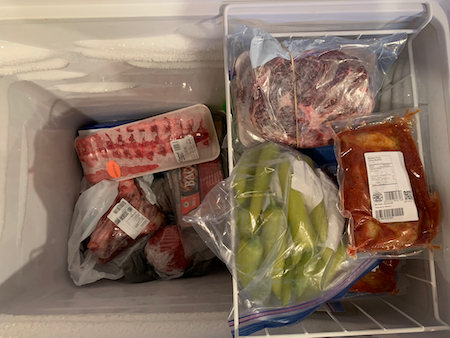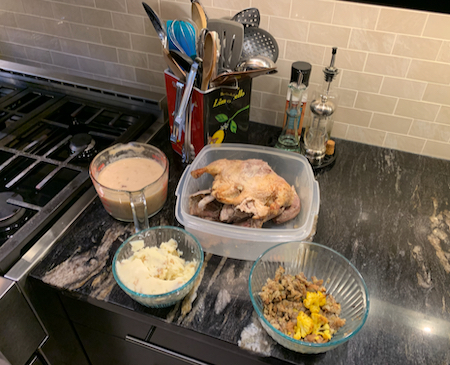As I was wrapping up my series of articles about income streams in retirement, a thought popped into my head. It happened as I was writing the “Other Actions … Get Stuff for Cheap or Even Free” section. And it wasn’t, “gee that’s a long subtitle” … the thought was, here I am telling people to scrutinize their grocery buying and meal planning closely to ensure they are not overspending in this area … perhaps I should be taking my own advice.
Although, I totally dissect our spending, I never give any thought to how much we are spending on groceries, or where we are buying groceries, or why we don’t take advantage of sales, or why we weren’t planning our meals in advance. Questions about what we might be having for a meal on any particular evening might centre around, what’s in the freezer that we can quickly thaw.
I was even oblivious to the fact that we were generally failing in this area. So, I made the decision to do a deep dive into this aspect of our home life and then write about it. Step 1, figure out how much we were spending per month on groceries. Step 2, come up with a plan that will help us reduce that amount. Step 3, report back to everybody on how this all turned out.
Step 1 – So How Much Were We Spending on Groceries?
Although I didn’t really give any thought to what we were spending on groceries I do track how much we were spending in this area, along with everything else. When I went back over the last six months I saw that we were spending on average $735 dollars a month on groceries. I have no idea if that’s average or above or below average for a couple.
This $735 figure does not include any spending on takeout or home delivery. During the pandemic we decided that we would try and order in once a week just to mix things up a bit and to help support local businesses. In reality, we prefer food prepared at home and have only ordered in, on average, a couple of times a month. So, spending money on a home delivery is a bit of an anomaly.
I love to cook, so it is no real hardship to prepare our own meals. Although we don’t really worry about what we’re spending on groceries, we’re not really keen on handing over money for restaurant-prepared food unless we are out dining as a social event… as if that will ever happen again.
Step 2 – Elements of the Plan
The Goal
The goal for this little project was to see if, with a bit of planning and a bit of selective grocery shopping and paying closer attention to our existing grocery inventory in the house, if we could pare our monthly grocery bill down by a reasonable percentage. As I begin this undertaking “a reasonable percentage” remains a little undecided. If I had to pick a number, I would say 25%. So, let’s go with that.
The other goal to all this is to see if I can develop a bit of a framework that you might be able to use to massage your own grocery costs downwards – thus, freeing up a bit more money for other fun things in retirement. The veritable win-win situation for all of us.
 Freezer and Pantry Diving
Freezer and Pantry Diving
I think where we’re really going to be able to have an impact on both our spending habits and meal planning is to give some serious thought to understanding what food we have kicking around the house, and then, planning meals around it. Even before we start saving money, let’s start by using up the money we have already spent.
The first step in all of this will be to do an inventory of what we have in the various freezers in our home. We have an apartment-size freezer in the storage room in the basement. There is also a “beer fridge” there with a freezer, and of course there is a freezer in the refrigerator in the kitchen. Usually, the first step in our just-in-time meal planning is to try and guess what we still have stashed away in a freezer that we can thaw.
Although this works, we both realize it’s not the best approach in the world to meal planning. So, we are committing to getting a handle on what we have on hand and maybe plan one or two weeks’ worth of meals in advance. Same goes with what is in our various cupboards and pantries.
Where We Shop, Where We Should Shop
We are generally lazy shoppers, I admit it. Typically, we just go to the large grocery store run by the Loblaws group nearby and pick up what we need. During the pandemic, we have frequently used their online service to place our orders and have used their curbside pickup service. Safe, but probably not the least expensive way to buy your groceries.
We have lots of interesting local and/or small chain grocery stores in our community. With a little bit of effort, we can vary where we shop to avail ourselves of better pricing. We are retired so we have the time, and we live in a relatively small community, so we don’t really have to drive all that far to get to any of these places.
Less Expensive Options
The other thing we will have a go at, is to look for some less expensive, but hopefully interesting, food products… especially cuts of meat. I suppose this will also involve us scrutinizing Flyers every week to look for the best pricing available on the things that we need.
 Flyers and Coupons
Flyers and Coupons
Speaking of which – we used to have all sorts of flyers delivered to our home every Thursday. However, during the pandemic this no longer happens. We both would look through them each week but they would not necessarily determine where we went shopping – unless we saw something that we loved to eat, was usually expensive, and rarely ever went on sale… for example, whole ducks for roasting. We really were not making the best use of these flyers.
I recently checked online for all of the places we could shop in town, and most offer online flyers. So that’s what I’m going to do every week. On Thursdays, I’m going to go through the various online flyers looking for the things we need and see if we can be a little more cost-effective in our grocery purchasing.
Using coupons does not seem to be as viable as it once was. I cannot recall seeing coupons in any grocery flyers for a long, long time now. When I asked a friend who I know is a very meticulous shopper about flyers and coupons, she told me that she will Google-search coupons for specific stores. Sure enough, when I checked, there were coupons available. They are not in the same profusion we used to get them in the paper flyers, but they are available.
Cash Back and Points
My shopping consultant also reminded me that it is a good idea to use points programs, such as PC Points or Airmiles, in the stores where they are offered or accepted. These will net savings on immediate and future purchases.
We are already all-over using our cash back charge card to purchase everything, so we are already getting a percentage of our grocery purchases back. I think some folks fail to realize that you can pay for your groceries with a charge card. In general, all stores will accept charge cards for any purchase of any amount.
If you spread our $735 a month spent on groceries over 12 months you will see that adds up to a relatively healthy amount… close to $9000. That amount is consistent with what we have been spending per year for the last few years. I am hoping that it does not take a lot of effort to whittle that down. Grocery shopping is definitely one of those areas where every penny saved is a penny earned.
 Leftovers and Food Waste
Leftovers and Food Waste
Finally, everyone has leftovers in their fridge on any given day. The concern here is what do we do with them. If you let them sit until you have to throw them out, then you are just throwing away money. One other impetus for this whole piece was an article I read recently on food wastage… which I can no longer find. When I went looking for that article, I found a mountain of others that talk about food wastage and what to do with your leftovers – from eating them, to freezing them, to using them in another recipe.
Abandoning leftovers is not really a big concern in our household. We generally do a good job of using them up. I love leftover spaghetti for breakfast. It is one of my favourite go-to ways to start the day. If you’re going to load up on carbs, you should probably do it first thing in the morning.
I can probably go on to say that how we address the leftover situation in our home is the best thing we do as it relates to food usage. We try to consume all, and waste as little as possible.
By way of a small example, anytime we roast a chicken or any other fowl, I will always make stock from the carcass. I always also chuck in any vegetables that are in the fridge that are getting to the point where we might not want to use them in our day-to-day cooking. This is then used immediately to make soup, or it goes into the freezer for future use, either in soup or a recipe that calls for stock. Bread that is not as fresh as we would like goes into the freezer, and then is later used up to make toast or toasted sandwiches.
That said, I am fairly certain that others don’t do quite as good a job as we do. Apparently, food wastage is a big problem in this country.
Here is a sampling of some of the articles I found. The first is entitled Food Waste in the Home on the Love Food Hate Waste Canada website. It provides some statistics related to food wastage in this country. The second is a link to a report about the impact of the pandemic on food wastage imbedded in a Rob Carrick article that speaks to food wastage in general and offers up some practical solutions.
This Scientific American article looks at food wastage as a universal problem. Another from the I Value Food website, offers up what it is calling creative ways to use leftovers.
And finally, an article by Teresa Prokopanko on the Green Action Pantry website speaks to much of what I am attempting here. She suggests taking her “Pantry Challenge” for a month or two to reduce waste and your grocery bills. Lots of good ideas here.
One of the things I really liked about all of these articles is that many of them offered up the same suggestions or ideas that I came up with. Made me feel like I was headed in the right direction.
That’s the Plan I Guess
After all of that, I think I have come up with a plan. Here it is!
- Plan our meals ahead of time
- Create an inventory of the food we already have in the house
- Use up food we already have in the house
- Check weekly flyers for savings on the things we need
- Plan out a shopping route of various places to buy from rather than just going to one store
- Look for interesting and less expensive food products
- Use up points or collect points for future purchases
- Make sure all leftovers get used up
The nice thing about working through the planning and writing of this article is that I feel that it has allowed me to come up with a meaningful approach to help us reduce our grocery costs. I will report back to you in April how this all worked out for us, and discuss how it might work out for you.
Bon Appetit!
Title Image by Sabine Soellheim

